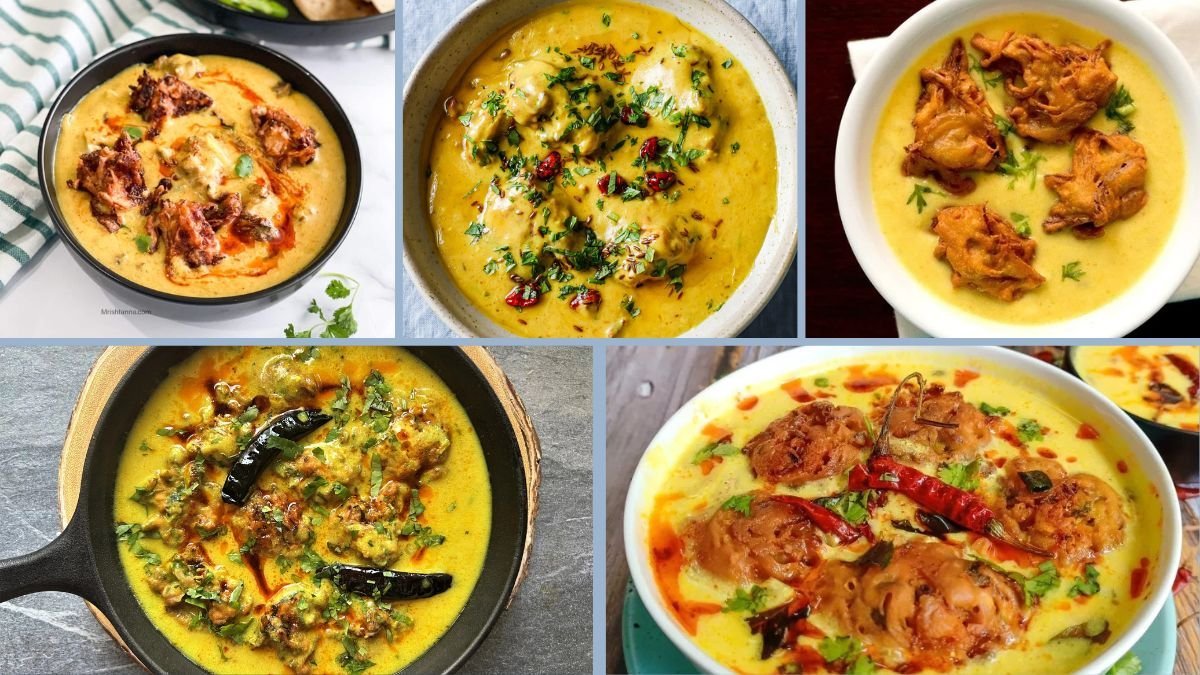Kadhi Pakora is a beloved dish across many parts of India — a tangy yogurt-based curry thickened with gram flour and studded with soft, flavorful pakoras (fritters). Traditionally, these pakoras are deep-fried and then simmered in the kadhi, making it rich, comforting, and hearty. However, for the health-conscious, the deep-frying can be a concern. The good news? You can still enjoy the same comforting taste without using excess oil.
This article explores a 6-step process to make delicious, healthier Kadhi Pakora at home — 100% vegetarian, with reduced oil, and no compromise on taste.
Why Kadhi Pakora?
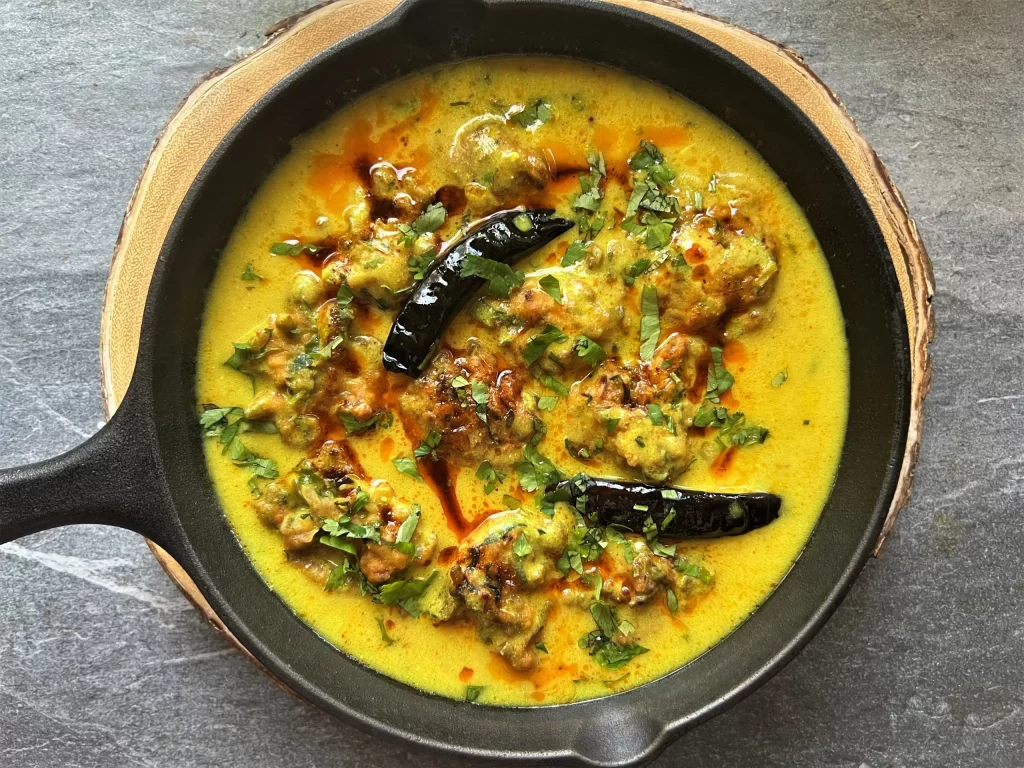
Kadhi Pakora is not just a dish; it’s a part of culinary heritage. Every region — from Punjab and Gujarat to Rajasthan — has its own variation. While Gujarati kadhi is thinner and sweeter, Punjabi-style kadhi is thicker, tangier, and usually includes onion or spinach pakoras.
Beyond the flavor, kadhi is easy on digestion, high in protein (thanks to yogurt and gram flour), and deeply comforting. This version keeps all the goodness intact while significantly reducing the oil content, making it perfect for regular meals, even for those watching their fat intake.
Ingredients You’ll Need
For the Kadhi:
- 2 cups sour yogurt (curd)
- ½ cup besan (gram flour)
- 4 cups water
- ½ teaspoon turmeric powder
- Salt to taste
For the Tempering (Tadka):
- 1 tablespoon oil or ghee
- 1 teaspoon mustard seeds
- 1 teaspoon cumin seeds
- 1 pinch asafoetida (hing)
- 2 dried red chilies
- 1 sprig curry leaves (optional)
- 1 green chili, slit
- ½ teaspoon fenugreek seeds (methi)
For the Pakoras (Low-Oil Version):
- ¾ cup besan (gram flour)
- 1 small onion, thinly sliced
- 2 tablespoons chopped spinach or fenugreek leaves (optional)
- Salt to taste
- ½ teaspoon ajwain (carom seeds)
- ¼ teaspoon turmeric powder
- ½ teaspoon red chili powder
- A pinch of baking soda (optional for fluffiness)
- Water to make batter
- 1–2 teaspoons oil (for shallow frying or air-frying)
Note: You can make the pakoras even healthier by air-frying or baking them instead of deep-frying.
Step-by-Step Recipe for Low-Oil Kadhi Pakora
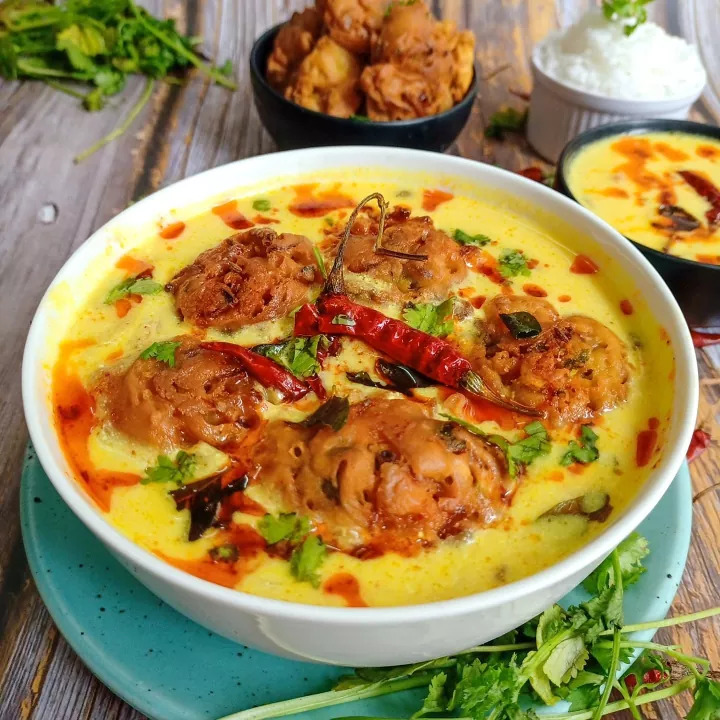
Step 1: Prepare the Kadhi Mixture
The base of kadhi is made with yogurt and besan. Using sour yogurt gives that characteristic tangy flavor.
- In a large bowl, whisk together the yogurt and besan until smooth with no lumps.
- Add 4 cups of water gradually while whisking to form a thin, lump-free mixture.
- Add turmeric and salt.
- Set aside.
Tip: If the yogurt isn’t sour, add a teaspoon of lemon juice or dried mango powder (amchur) later during cooking.
Step 2: Make the Pakora Batter (Low-Oil Method)
Traditional pakoras are deep-fried, but we’ll use much less oil — without compromising texture.
- In a bowl, combine besan, sliced onions, spinach/fenugreek leaves (if using), ajwain, salt, turmeric, and chili powder.
- Mix everything and let it sit for 5–10 minutes. The onions will release water.
- Add minimal water to form a thick batter — it should hold shape.
- Add a pinch of baking soda if you want fluffier pakoras.
Step 3: Cook the Pakoras (Without Deep Frying)
Here’s how to make pakoras without excess oil:
Option A: Shallow Frying
- Heat 1–2 teaspoons of oil in a non-stick or cast-iron pan.
- Drop small spoonfuls of the batter and cook on medium heat.
- Flip once golden brown on one side.
- Cook until crispy and golden on both sides.
Option B: Baking or Air-Frying
- Preheat the oven to 180°C (350°F).
- Line a tray with parchment paper and lightly grease it.
- Drop spoonfuls of batter and bake for 18–20 minutes, flipping halfway through.
- Alternatively, use an air fryer at 180°C for 15–18 minutes.
Result: Crispy on the outside, soft on the inside — just like traditional pakoras but much healthier.
Step 4: Cook the Kadhi
- Pour the kadhi mixture into a large pot or deep pan.
- Turn on medium heat and bring it to a boil while stirring continuously to prevent curdling.
- Once it starts boiling, reduce heat and let it simmer for 20–25 minutes.
- Stir occasionally to prevent sticking at the bottom.
The kadhi will thicken and develop flavor as it cooks. Longer simmering makes it tastier.
Step 5: Add the Pakoras
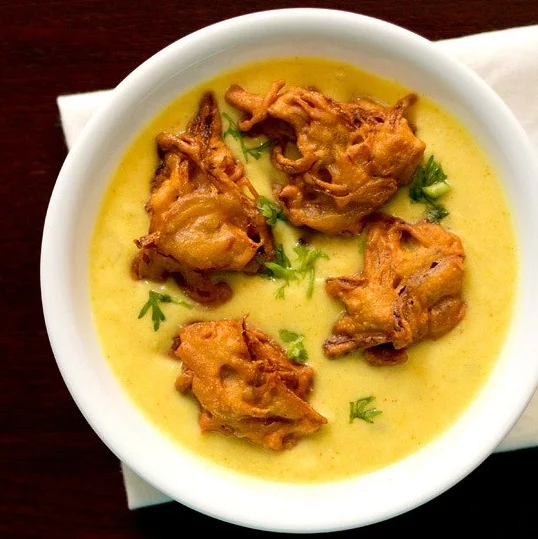
Once the kadhi has simmered:
- Gently drop the cooked pakoras into the simmering kadhi.
- Let them soak in the kadhi for 5–10 minutes. They will absorb the flavors and soften slightly.
You can add the pakoras just before serving if you prefer them slightly crisp.
Step 6: Tempering (Final Tadka)
This final step enhances the aroma and taste of kadhi.
- Heat 1 tablespoon oil or ghee in a small pan.
- Add mustard seeds, cumin, fenugreek seeds, asafoetida, red chilies, green chili, and curry leaves.
- Let everything sizzle for 30 seconds.
- Pour the hot tempering over the kadhi.
- Cover the pot for a minute to lock in the aroma.
Serving Suggestions
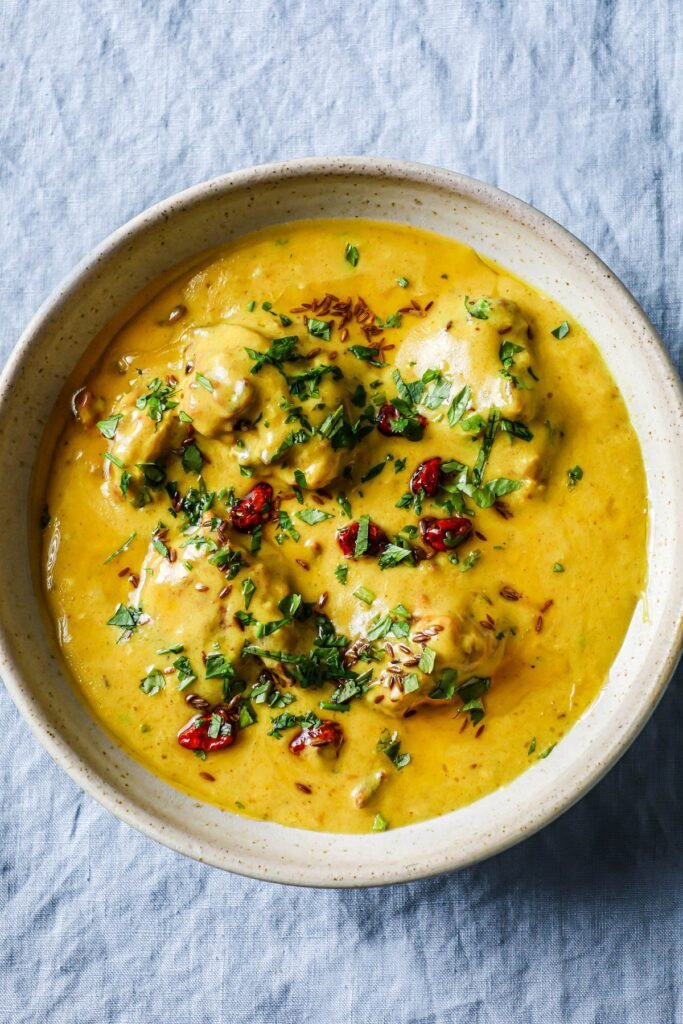
- Serve hot with steamed basmati rice or jeera rice.
- Pair with roti or paratha for a wholesome meal.
- Accompany with sliced onions, green chili, and a spoonful of pickle.
Bonus Tip: A light salad or plain papad complements this dish well.
Health Benefits of This Low-Oil Kadhi Pakora
- High Protein: Yogurt and besan provide plant-based protein.
- Rich in Probiotics: Fermented curd supports gut health.
- Low in Oil: Uses minimal oil without sacrificing flavor.
- Vegetable Additions: Spinach or fenugreek in pakoras adds vitamins and fiber.
- Good for Digestion: Spices like cumin, fenugreek, and hing aid digestion.
Common Mistakes to Avoid
- Curdling the Yogurt: Always stir while heating the yogurt mixture initially.
- Adding Pakoras Too Early: They can become overly soggy. Add them closer to serving time.
- Using Cold Yogurt: Bring yogurt to room temperature before cooking.
- Overcrowding While Frying: Whether shallow-frying or baking, space out the pakoras for even cooking.
- Skipping Tempering: The tadka elevates flavor — don’t miss it.
Nutritional Breakdown (Per Serving Estimate)
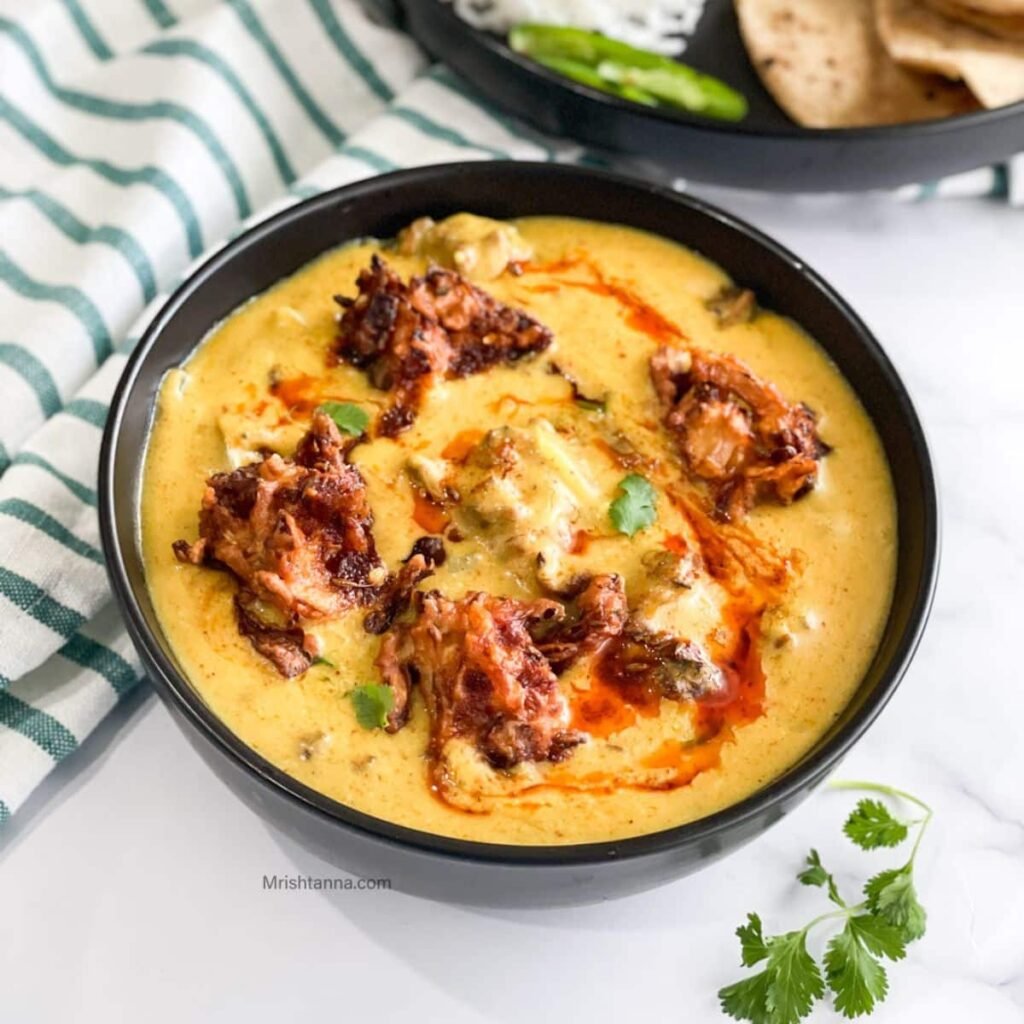
- Calories: ~220 kcal
- Protein: 9–10g
- Fat: 6–8g (significantly lower than deep-fried version)
- Carbs: 20–25g
- Fiber: 3–4g
Values may vary based on portion size and ingredients used.
Conclusion
Kadhi Pakora, often considered a heavy, indulgent dish, can be transformed into a light, nutritious, and heart-healthy meal by reducing oil and embracing modern cooking methods like baking or air-frying. With this 6-step recipe, you no longer need to compromise your health goals to enjoy this traditional comfort food.
Perfect for weekday dinners or weekend indulgence, this low-oil kadhi pakora is flavorful, comforting, and guilt-free — proving that even the most beloved traditional dishes can be reimagined for a healthier lifestyle.
So next time you’re craving something tangy, warm, and satisfying, give this version a try — and enjoy all the taste, minus the extra oil.
